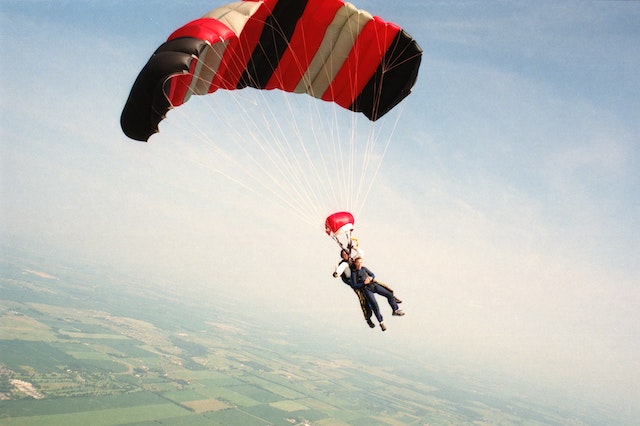
How does a parachute work? A parachute works because of air resistance.
If you jump out of an airplane, presuming you are high enough, you are going to accelerate until you reach terminal velocity. Terminal velocity is the maximum speed an object can attain when falling through a fluid. And here is the point that surprised me: air is a fluid. Air is a gas, but gases can be fluids because of the way that they behave. Any substance that flows is a fluid and air has particles that flow.
When you jump out of the airplane, you are going to accelerate because you are being pulled down by gravity. As your speed increases, more and more of the fluid air has to move out of your way. The air requires force to be moved and this force pushes back against you. If you are in a skydiving position, you will reach about 200 km/h and you won’t be able to go any faster because it would require more force to move the air out of your way than gravity can provide. If you turn your body so you are upright, your speed will increase to about 320 km/h. This is because you have reduced your surface area and there is less air pressing up against you. However, at 320 km/h, the pull from gravity equals the push from the air and you stop accelerating.
This is how a parachute works. Gravity pulls on all things equally and all things fall with the same acceleration. However, their surface area dictates their terminal velocity. If you get two sheets of paper and crumple one up, it will obviously hit the ground faster than the flat sheet. This is because the surface area increases the amount of air that has to be moved out of the way for the object to fall. You can feel the force of air resistance if you put your hand out of a car window while you are driving along. The force that pushes your hand back is the same force that gravity has to fight against.
When the freefalling skydiver opens their parachute, it rapidly expands and increases the skydiver’s surface area. Their mass doesn’t change, but their surface area does. There are many different sizes of parachute, and the size is calculated based on the weight of the person jumping plus all of their gear. A person of 80 kg (176 lbs) should use a parachute canopy of 20.9 square meters (225 square feet). The 80kg person will suddenly have a surface area that stops them accelerating at 200 km/h. If you hit the ground at 200 km/h, the G-force will kill you. When the parachute is unfurled, the surface area increases to 20.9 square meters and the acceleration drops to 22.5 km/h. This is the speed the 80 kg person would have reached if they had jumped off a 2-meter-high wall. That is why parachutists used to practice the drop and roll landing.
These days, modern parachutes have a much more gentle landing. They use something called ram-air. This is where air is “rammed” into chambers that run along the parachute. Air enters the front of the parachute and inflates it, giving the parachute more of a rigid shape than older parachutes. When the parachutist comes in to land, they pull the steering toggles which cups the back of the parachute creating lift for the briefest of moments. This slows the rate of descent down to almost zero and the parachutist can land very comfortably.
Because of the way air behaves, anything can be slowed down if it has a parachute with a large enough surface area. The army regularly drops supplies, weapons, and even vehicles using parachutes. The heaviest thing ever dropped by parachute was a 35 ton weight. The drop was performed by NASA to see how strong their new parachute was. If there is a big enough parachute, you can drop anything.
The ratio of surface area to weight is also the reason why small animals can fall from staggering heights and walk away. If a mouse falls off a building, it reaches a terminal velocity of about 27 km/h. That is fairly fast, but it is survivable. It would be the same as you or I jumping off a 3m high wall. It would sting a bit, but if you landed properly, you would probably walk away most of the time. When cats fall off a high building, they extend their legs into a skydiving pose and reduce their terminal velocity.
So, how does a parachute work? By increasing the surface area of the falling person and increasing the amount of air that has to be moved aside. And this is what I learned today.
Sources
https://wonderopolis.org/wonder/how-does-a-parachute-work
https://en.wikipedia.org/wiki/Terminal_velocity
https://www.twinkl.jp/teaching-wiki/air-resistance
https://www.wired.com/2013/10/do-heavier-objects-really-fall-faster/
https://axis.tools/tool_Down.php
https://www.omnicalculator.com/physics/free-fall
https://www.skydivecarolina.com/blog/parachute-landings-explained/
https://www.nasa.gov/mission_pages/constellation/ares/H10-134.html
